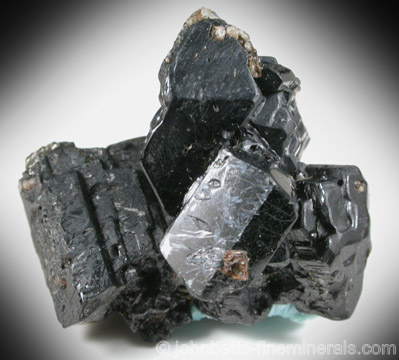The hornblende Mineral Group

Hornblende is a group name used to describe Ferro-hornblende and Magnesio-hornblende, but the term is generally more inclusive for all calcium aluminum amphiboles. (Hornblende is frequently also used to describe any dark, opaque amphibole mineral without individual analysis.) The individual Hornblende minerals appear very similar and can be
virtually indistinguishable without complex analysis, and are often just grouped under a Hornblende label without further distinguishing.
Hornblende is major constituent of the earth and is extremely common. It forms in a host of different mineral environments, and is often a major constituent of the rock type it forms in. Hornblende is a rock-forming mineral, and it even constitutes its own rock type known as Horneblendite, a dark rock formed mostly from Hornblende.
Hornblende is named after the German term horn, referring to its color, and blenden, meaning "deceiver", alluding to its habit of being confused with ore metals due to its dark color and luster. Its typical dark color and
opacity are usually caused by iron in its structure.
Chemical Formula
General Formula: Ca2(Mg,Fe2+,Fe3+,Al)5(Si,Al)8O22(OH)2
Magnesio-hornblende: Ca2Mg3,(Al,Fe)Si7AlO22(OH)2
Ferro-hornblende: Ca2Fe2+4,(Al,Fe)Si7AlO22(OH)2
Color
Black, dark green, dark brown, dark gray. (Lighter colors are encountered in the extended Hornblende group, which includes members such as Edenite and Pargasite.)
Crystal System
Monoclinic
Uses
Hornblende is usually an uninteresting gangue material, especially when it is confused with ore minerals due to its shiny luster. Good crystals are infrequent and are used as collector's material when found. Hornblende is a constituent of granite, and is responsible for the black streaks in the granite that provide a desirable color variety and contrast.
Noteworthy Localities
Although Hornblende is fairly abundant and occurs worldwide, good display crystals are not commonly encountered. Due to the difficulty in determining the scientific Hornblende type, the locality list below is a global Hornblende list. However, localities for Edenite, Pargasite, and Hastingsite will be listed separately on their dedicated information pages.
Lustrous, well-formed crystals, mostly as microcrystals, come from the Italian volcanoes at Monte Somma,
Vesuivius; and at the Montenero Quarry, Latera, Lazio Province. Exceptional crystals in relatively large prismatic crystals have come from Studsdalen, near Kragerø, Telemark, Norway. Other Norwegian localities include Arendal, Langesundfjord; and several localities in Risør, Aust-Agder. Dark green Hornblende was found in Malmberget, Gällivare, Sweden; and doubly terminated floater crystals have come from Žim (Schima), Teplice, Bohemia, in the Czech Republic.
In the U.S., shiny Hornblende crystal plates have come from the iron mines in the Jersey Highlands in Bergen, Passaic, and Sussex Counties, New Jersey; and across the state border in the Ramapo Mountains and Hudson Highlands Region in Rockland, Orange, and
Putnam Counties. Good Hornblende crystals have come from upstate New York regions in St. Lawrence Co. at Edwards, Pierrepont,
Gouverneur, and Russel. In Canada, lustrous, well-formed stubby crystals come from Bancroft, Ontario; and at the Bear Lake Diggings in Gooderham, Haliburton Co., Ontario.
Distingushing Similar Minerals
Augite - Different cleavage angles.
Schorl - Lacks the good cleavage, is heavily striated, and different crystal form.
Actinolite and Diopside - Lighter in color.